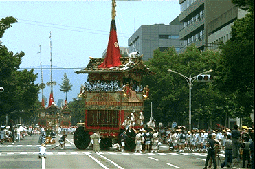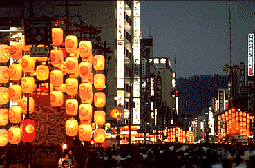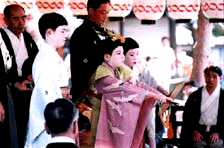ANNUAL CALENDAR July |
|
Gion Festival
|
 The Gion Festival is a spectacular event held at Yasaka Shrine in Japan's ancient city of Kyoto. Many people visit Kyoto each year just to attend this famous festival. The Gion festival and the Aoi festival are two of Kyoto's most famous festivals. The Gion Festival got started in the year 896, when a serious illness was sweeping through Kyoto. To stop the epidemic, the people offered prayers to the god of good health. They also erected 66 tall spears, representing the 66 provinces of Japan.
The Gion Festival is a spectacular event held at Yasaka Shrine in Japan's ancient city of Kyoto. Many people visit Kyoto each year just to attend this famous festival. The Gion festival and the Aoi festival are two of Kyoto's most famous festivals. The Gion Festival got started in the year 896, when a serious illness was sweeping through Kyoto. To stop the epidemic, the people offered prayers to the god of good health. They also erected 66 tall spears, representing the 66 provinces of Japan.
The Gion Festival is huge. The festivities go on for about a month. The high point of the Gion Festival is the parade of floats that takes place on July 17. There are two kinds of floats: yama and hoko. Hoko are giant floats on wheels. These are up to 25 meters long and weigh up to 12 tons. Some hoko are two stories high, with people standing on each level and even on the roof! Although the hoko are huge, they have no engines. Instead, they are pulled by people! Yama are smaller floats carried on the shoulders of several people. There are 32 floats in the parade: 25 yama floats and 7 hoko floats.  When the big floats have to turn at an intersection, the float pullers gear up for the turn by chanting loudly, "Yoi, yoi, yoi-toh-say! " Their energetic shouts are accompanied by traditional Japanese music. This music is played by musicians who are on the second story of the two-story floats. The shouting and the music are the best part of the Gion Festival.
When the big floats have to turn at an intersection, the float pullers gear up for the turn by chanting loudly, "Yoi, yoi, yoi-toh-say! " Their energetic shouts are accompanied by traditional Japanese music. This music is played by musicians who are on the second story of the two-story floats. The shouting and the music are the best part of the Gion Festival.
The order of the floats in the parade is determined by a drawing held on July 2. But there are eight special floats that don't participate in the drawing. That's because these floats always go in the same order every year. One of these floats is the hoko that leads the parade. The head float is special because it's the only one that a kid gets to ride on alone. The one who gets to ride on it is the child who has been chosen to represent the shrine god.  In 1997, a 10-year-old fifth-grade boy named Keita Miki was chosen to ride on the float. Keita is a student at an elementary school in Kyoto. Before the parade starts, there's a rope stretched across the starting line. Keita, sitting at the center of the head float, started the parade by cutting the rope with a long sword.
In 1997, a 10-year-old fifth-grade boy named Keita Miki was chosen to ride on the float. Keita is a student at an elementary school in Kyoto. Before the parade starts, there's a rope stretched across the starting line. Keita, sitting at the center of the head float, started the parade by cutting the rope with a long sword.
All of the floats are beautifully decorated with patterned fabrics. Many of these fabrics come from Nishijin, a long-established merchant in Kyoto. Nishijin is known for its traditional Japanese dyed fabrics. But some of the fabrics decorating the floats are produced using techniques imported from Korea, China, India, Persia, and Belgium. Some of the patterns even depict figures from Western myths and legends. This gives the parade an international flavor. Some of the cloths used to decorate the Gion floats were on display at the New York Metropolitan Art Museum in November 1997. They were part of an exhibit titled "Flowers Underfoot: Indian Carpets of the Mughal Era." This was the first time for Gion float cloths to appear outside of Japan.
Photos: (Top) A giant hoko rolls along the parade route; (middle) the streets are lit up with lanterns (Kenzo Yokoyama); (above) Keita Miki, in pink, led the people in 1997. (Kyoto Shimbun Newspaper) |
APR | MAY | JUN | JUL | AUG | SEP | OCT | NOV | DEC | JAN | FEB | MAR |
 |